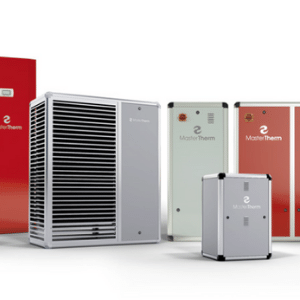Blog

Air Source Vs Ground Source Heat Pumps
Posted on 30 March 2021 in Blog
We've been supplying both air source and ground source heat pump systems since 2006 and offer impartial advice on which system is best suited for any given project. Whilst we've put together this information to help provide guidance, every building and project is different. If you'd like to talk to us about your project and get some free no obligation advice, we're always happy to help.
HOw does each heat pump work?
Air Source Heat Pumps

An air source heat pump is installed outside a property and works in a similar way to a fridge or freezer, but in reverse. Instead of drawing in air and cooling it like a fridge, it draws in air and warms it. The fan draws in the air which contains thermal energy and passes it over a heat exchanger which circulates a fluid that absorbs the energy, transferring it to a compressor which raises the temperature to a usable level and it's then distributed to radiators, underfloor heating, your hot water tank etc to provide hot water and space heating.
Ground Source Heat Pumps

Ground source heat pumps are installed inside a building and connected to a series of pipes called ground collectors which are buried underground. The ground collectors circulate a fluid which absorbs thermal energy from the ground. From here the system works in the same way to air source - the thermal energy is circulated through a compressor which raises the temperature to a usable level and it's then distributed to radiators, underfloor heating, your hot water tank etc to deliver heating and hot water.
More on Ground Source Heat Pumps
Price
The price of the individual heat pump unit varies by make, model and heat output. Depending on which make and model you opt for can also impact on other parts of the system e.g. some MasterTherm AquaMaster heat pumps do not require a buffer tank and the AquaMaster Combi has an integrated hot water tank so you won't need to purchase these parts seperately. If we look specifically at MasterTherm, the difference in price for the actual heat pump is not so different between air and ground - prices start for each at around £6,700. The difference lies in the installation costs.
Air Source
Air source heat pumps are relatively straightforward to install and all works can be completed in as little as 2 days. As an overall installation project we would recommend budgeting somewhere between £8,500 and £15,000.
Ground Source
Ground source heat pumps require a significant amount of system design and ground works for installation. Whether you have vertical (boreholes) or horizontal (straight pipes or slinkies) can impact the price further - boreholes are more expensive due to the specialist equipment and drilling engineers required. Installations can take anywhere from 2-4 weeks. We recommend budgeting from £18,000 upwards.
Renewable heat incentive
The Renewable heat incentive (RHI) was established by the government to help reduce carbon emissions in the UK. Air and Ground Source heat pumps are both eligible for the renewable heat incentive which means you can benefit from quarterly payments from the government for a total period of 7 years after the date of installation.The amount of you receive depends on factors like the type of system and the kilowatt hours (kWh) your system produces. In most cases you will receive a complete return on your investment or actually make a profit. The RHI is ending in March 2022 and for your heat pump to be eligible your chosen installer will need to be certified under the Micro-generation Certification Scheme (MCS). The RHI tariff is subject to change but you can view the most recent version here.
Below we've provided estimates for a property that has a hot water and heating demand of 30,000 kWh/yr and a SCOP rating of 3.
Air Source
As air source heat pumps are less efficient than ground source heat pumps and so the tariff is lower (10.92p), the total payment after 7 years would be £15,288
Ground Source
GSHP's have a tariff of 21.29p, the total payment after 7 years would be £29,806
INSTALLATION PROCESS
Air Source
As mentioned above, air source heat pumps are relatively straightforward to install and be fitted in around 1-2 days. The pumps are mainly installed on side or rear-facing walls. There are restrictions on how close you can install your heat pump to your neighbours residence, in England and Scotland it must be 1 metre away and in Wales it must be 3 metres away. In most cases you won't need planning permission for an air source, but there are exceptions. You can find excellent guidance on these exceptions on Planning Portal.
Ground Source
The installation of a ground source heat pump is notoriously quite messy. If you have horizontal trenches you'll have an excavator on site digging trenches around 1 metre deep and approx 100 metres long and you'll need space to put the earth that's been dug up so that it can be replaced once the ground collector pipes have been laid. If the weather has been particularly wet surrounding the installation date then you can just imagine the mud. When it comes to drilling boreholes, this can be quite noisy for the first few metres so if you have neighbours close by you may want to let them know what's happening and apologise for any disruption in advance. Boreholes also produce a lot of dust, mud and water that can flow out of the hole and across the land surface. They are often drilled to around 100 metres deep and take around 1 day to drill this far. We recommend planning for the installation to take around 2 to 6 weeks as an approximate guide.
Size and space
Heat pumps come in a variety of sizes, varying by make and model. When it comes to the actual heat pump there is not always much difference in size.
Air Source

Air source heat pumps are available in a variety of sizes, the smallest MasterTherm BoxAir model measures W 1300mm X H 885cm X D 526 making it quite compact. The largest measures the same width and depth as the smaller model but is 1495mm high. One of the most attractive points of an air source compared to almost any other type of heating system, is that it is installed outdoors which frees up valuable indoor space. When considering space for an air source, you also might want to think about how far away it is from any outdoor sitting areas you have. Although air source heat pumps are specially insulated to decrease any noise output, there will undoubtedly be a hum that wasn't there before.
Ground Source

Ground source heat pumps can vary quite considerably in size and even if you'd like to opt for the smallest size possible, it may not provide the heat output required for your property. The smallest model provided by MasterTherm is an AQ17i which measures W 530mm X H 815mm X D 830mm which is small enough to fit in an airing cupboard or space underneath the stairs. The largest MasterTherm unit is roughly around the same size as a standing fridge freezer and it's not this size because it has a higher output, it's because it has an integrated hot water tank, so this actually helps to save on space and reduces installation time and cost. Where a ground source heat pump needs a lot of space is for the ground collectors. If you have a large amount of land surrounding the property you may want to opt for horiztonal ground collectors but if space is more restricted you could opt for boreholes. You'll need room for the drilling rig to enter the site but the actual borehole is only around 20cm across and if you require more than one they are often drilled around 5-6 metres apart. Find out more about how much space is needed on our dedicated blog around the topic.
Maintenance
One of the benefits of a renewable heating system like heat pumps is they only require little ongoing maintenance. A high quality install of an air or ground source heat pump and with annual services you can expect to last for at least 20 - 30 years. Like other heating systems, annual service checks will be required to keep the heat pump updated and to ensure everything is running as smoothly and efficiently as it should be. If you are considering applying for Domestic RHI then regular maintenance and upkeep of your system is a guideline set out by the government to ensure you continue to receive the quarterly payments.
Most heat pumps come with a warranty and the length of these can vary. As an example, MasterTherm offer a 7 year warranty with their heat pumps.
Here at Thermal Earth we offer inverter and fixed output systems, inverter heat pumps can offer greater efficiency and longer unit lifespan. Click here to read more about the pros and cons of inverter vs fixed outputs heat pumps.
Air Source - ASHP'S require little ongoing maintenance. A service for an air source heat pump will cost around £150 + VAT. On the topic of maintenance, a question we are sometimes asked is if you need a particular model of air source if you are located in a coastal area as salt can oxidise metals and the answer is no. We coat our air source heat pumps with a special fluid which helps protect the unit from the sea air.
Ground Source - Similar to air source, ground source heat pumps require limited maintenance but services can be slightly more expensive at approx £190 + VAT. Typically, ground source heat pumps tend to last longer than air source heat pumps and the ground collectors can last 100 years+ making them an excellent investment.
Efficiency and operating costs
For many of our customers this is the most important factor between an air and ground source heat pump. Many people chose to pay the higher upfront cost of installing a ground source heat pump because they are more efficient to run and will enable greater savings on energy bills than air source.
Air Source
Air source heat pumps operate at around 300% efficiency, producing 3kWh of heat for every 1kW of electricity. This efficiency can change throughout the seasons, as the weather turns colder the heat pump will work harder so this efficiency can change.
Ground Source
Ground source heat pumps operate at around 400% efficiency, producing 4kWh of heat for every 1kW of electricity. As the temperature in the ground is more consistent than air temperature, they can deliver this greater efficiency year round.
An added benefit of both the air source and ground source heat pumps we offer is that they are compatible with time of use tariffs such as those offered by Octopus Energy and Bulb. These providers also use 100% renewable electricity so your entire system will be clean and carbon free, saving the average household from producing around 3 tonnes of carbon every year. Time of use tariffs reflect the wholesale price of electricity as it changes every 30 minutes through the day. If you can switch your energy consumption to off-peak periods you'll save on your energy bill. MasterTherm heat pumps integrate with Homely Energy smart meters to operate as economically and efficiently as possible, saving you money without you needing to lift a finger.
making a decision
If you're still unsure which type of heat pump is right for you and your property, get in touch with today and we can help with free, no obligation advice. We also carry out a site visit and provide accredited heat loss and heat load reports to provide greater insight on the requirements your heating system will need.
Submit an enquiry today or call us on 01269 833 100.
 Facebook
Facebook LinkedIn
LinkedIn Twitter
Twitter














